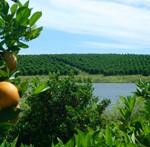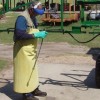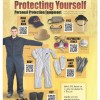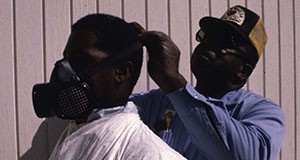In 1992, the US Environmental Protection Agency (EPA) issued a comprehensive regulation called the Worker Protection Standard for Agricultural Pesticides (WPS). The EPA has made several changes to the WPS since it was fully implemented in 1995. On November 2, 2015, the EPA made significant changes to the rule’s requirements. Most of the revised provisions will become effective January 2, 2017 and there are four provisions that are delayed until January 2, 2018. This five-page fact sheet answers questions regarding changes made to the exemptions for Certified Crop Advisors. Written by Frederick M. Fishel and Tatiana Sanchez and published by the Agronomy Department.
http://edis.ifas.ufl.edu/pi265
Tag: Personal Protective Equipment (PPE)
Worker Protection Standard: Notification and Hazard Communication
In 1992, the US Environmental Protection Agency (EPA) issued a comprehensive regulation called the Worker Protection Standard for Agricultural Pesticides (WPS). The EPA has made several changes to the WPS since it was fully implemented in 1995. On November 2, 2015, the EPA made significant changes to the rule’s requirements. Most of the revised provisions will become effective January 2, 2017 and there are four provisions that are delayed until January 2, 2018. This five-page fact sheet answers questions regarding changes made to the rules about notification and hazard communication. Written by Frederick M. Fishel and Tatiana Sanchez, and published by the Agronomy Department.
http://edis.ifas.ufl.edu/pi266
Worker Protection Standard: Personal Protective Equipment (PPE) 2016
In 1992, the US Environmental Protection Agency (EPA) issued a comprehensive regulation called the Worker Protection Standard for Agricultural Pesticides (WPS). The EPA has made several changes to the WPS since it was fully implemented in 1995. On November 2, 2015, the EPA made significant changes to the rule’s requirements. Most of the revised provisions will become effective January 2, 2017 and there are four provisions that are delayed until January 2, 2018. This five-page fact sheet answers questions regarding changes made to the rules about Personal Protective Equipment (PPE). Written by Frederick M. Fishel and published by the Agronomy Department.
http://edis.ifas.ufl.edu/pi267
Guia de gestion de plagas para citricos en la Florida 2014: Interpretacion de los enunciados de PPE en las etiquetas de pesticidas
 Este documento le ayuda a comprender los enunciados revisados para Equipo de Protección Personal (PPE) que ahora hacen parte de las etiquetas de los productos pesticidas utilizados en las fincas, bosques, viveros e invernaderos. This 3-page fact sheet is a Spanish-language translation of 2014 Florida Citrus Pest Management Guide: Interpreting PPE Statements on Pesticide Labels. Written by O. Norman Nesheim, Frederick M. Fishel, and Tatiana Sanchez, and published by the UF Department of Agronomy, September 2013.
Este documento le ayuda a comprender los enunciados revisados para Equipo de Protección Personal (PPE) que ahora hacen parte de las etiquetas de los productos pesticidas utilizados en las fincas, bosques, viveros e invernaderos. This 3-page fact sheet is a Spanish-language translation of 2014 Florida Citrus Pest Management Guide: Interpreting PPE Statements on Pesticide Labels. Written by O. Norman Nesheim, Frederick M. Fishel, and Tatiana Sanchez, and published by the UF Department of Agronomy, September 2013.
http://edis.ifas.ufl.edu/cg089
Equipo de Proteccion Personal para la Manipulacion de Pesticidas (PI243)
 Este documento describe diversos artículos de equipo de protección personal (EPP) que se usan para proteger el cuerpo humano del contacto con pesticidas o residuos de pesticidas. El EPP incluye elementos tales como overoles o trajes protectores, calzado, guantes, delantales, mascarillas, gafas y sombreros. This 12-page fact sheet was written by Frederick Fishel, and published by the UF Department of Agronomy, December 2012.
Este documento describe diversos artículos de equipo de protección personal (EPP) que se usan para proteger el cuerpo humano del contacto con pesticidas o residuos de pesticidas. El EPP incluye elementos tales como overoles o trajes protectores, calzado, guantes, delantales, mascarillas, gafas y sombreros. This 12-page fact sheet was written by Frederick Fishel, and published by the UF Department of Agronomy, December 2012.
http://edis.ifas.ufl.edu/pi243
Pesticide Safety Miniposter: Protecting Yourself (ENY2010/IN960)
 To properly apply pesticides, a technician must be aware of the personal protective equipment, or PPE, required for the application. This poster introduces new pest control technicians to different types of PPE they may be required to wear during a pesticide application or pest management inspection. There is a wide array of examples of PPE on the poster, with quick response (QR) codes that direct smartphones to short, online videos explaining PPE for each area of the body (head, eyes, face, mouth, hands and arms, torso and feet). This poster will serve as a valuable training tool for new technicians and a refresher tool for pest managers. Designed by R.W. Baldwin, S.K. Hill, Philip Koehler, W. Walker, and J.C. Medley, and published by the UF Department of Entomology and Nematology, August 2012.
To properly apply pesticides, a technician must be aware of the personal protective equipment, or PPE, required for the application. This poster introduces new pest control technicians to different types of PPE they may be required to wear during a pesticide application or pest management inspection. There is a wide array of examples of PPE on the poster, with quick response (QR) codes that direct smartphones to short, online videos explaining PPE for each area of the body (head, eyes, face, mouth, hands and arms, torso and feet). This poster will serve as a valuable training tool for new technicians and a refresher tool for pest managers. Designed by R.W. Baldwin, S.K. Hill, Philip Koehler, W. Walker, and J.C. Medley, and published by the UF Department of Entomology and Nematology, August 2012.
http://edis.ifas.ufl.edu/in960
Personal Protective Equipment (PPE) Reference Guide for Low-Volume Ground Citrus Applicators (CH203)
 This 2-page fact sheet provides a table describing personal protective equipment requirements for several products used in citrus production. Written by S.H. Futch, L.L. Stelinski, M.E. Rogers, and J.D. Yates, and published by the UF Department of Horticultural Sciences, July 2011.
This 2-page fact sheet provides a table describing personal protective equipment requirements for several products used in citrus production. Written by S.H. Futch, L.L. Stelinski, M.E. Rogers, and J.D. Yates, and published by the UF Department of Horticultural Sciences, July 2011.
http://edis.ifas.ufl.edu/ch203
PI77/PI114 Respirators for Pesticide Applications
Revised! PI77, a 6-page illustrated fact sheet by Frederick M. Fishel, provides guidance for selecting an appropriate respirator and using it properly. Includes references. Published by the UF Department of Agronomy, May 2010.
http://edis.ifas.ufl.edu/pi114
CH203 Personal Protective Equipment (PPE) Quick Reference Guide for Low Volume Citrus Applications
CH203, a one-page fact sheet by S.H. Futch, L.L. Stelinski, M.E. Rogers and J.D. Yates, provides a table describing personal protective equipment requirements for several products used in citrus production. Published by the UF Department of Entomology and Nematology, September 2009.
http://edis.ifas.ufl.edu/ch203
PI28/PI061 Personal Protective Equipment for Handling Pesticides
Revised! PI-28, a 12-page illustrated fact sheet by Frederick Fishel, describes various articles of personal protective equipment (PPE) that are worn to protect the human body from contact with pesticides or pesticide residues. PPE includes such items as coveralls or protective suits, footwear, gloves, aprons, respirators, eyewear, and headgear. Includes references. Published by the UF Pesticide Information Office and Agronomy Department, July 2009.
http://edis.ifas.ufl.edu/PI061
PI-165/PI201 Protecting Your Eyes from Pesticide Exposure
PI-165, a 4-page illustrated fact sheet by Frederick Fishel, describes various types of personal protective equipment (PPE) appropriate for providing eye protection as required on pesticide labels. Includes references. Published by the UF Department of Agronomy, July 2008.
http://edis.ifas.ufl.edu/PI201
